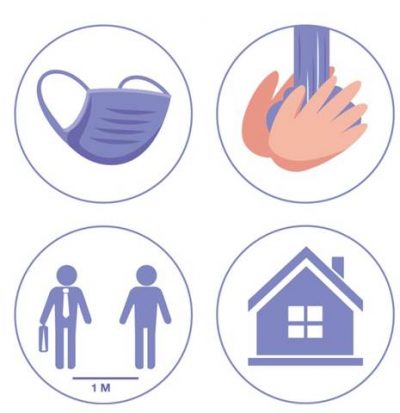When COVID-19 cases began to emerge in early 2020, many people thought it was just another type of flu. After millions of cases and extended quarantines around the world, it was obvious that COVID-19 is a completely different illness. How are these two viral infections different from one another?
Until mid-December 2020, more than 72.5 million COVID-19 cases have been confirmed, with more than 1.6 million deaths recorded worldwide. No one would have expected that a viral infection, which started in Wuhan, China in December 2019, could have impacted the world to this magnitude as we enter the new decade. For comparison, the World Health Organization estimates that 1 billion people worldwide are down with flu every year, resulting in 290,000 to 650,000 flu-related deaths.
COVID-19 and influenza are often compared, as both are viral respiratory illnesses. However, there are key differences between the two viruses and how they spread. These factors have important implications in the way we respond to viral outbreaks.
SARS-CoV-2 vs influenza virus
Both COVID-19 and influenza are caused by virus. COVID-19, or coronavirus disease 2019, is caused by SARS-CoV-2 (severe acute respiratory syndrome coronavirus 2), a strain of coronavirus. As it is a novel virus, no treatments or immunity are available; this is one of the factors causing the infection to spread unrestrained and develop into a pandemic of this scale.
For flu, it is caused by influenza virus, which comprises four strains (A, B, C, D) and many different subtypes. Seasonal flu outbreaks are commonly caused by influenza A and B strains. Constant genetic shifts in influenza virus require us to take flu vaccine annually to effectively protect us from influenza.
Similar symptoms
An aspect of COVID-19 which is often linked to flu is the similar symptoms manifested in both illnesses. These include fever, cough, fatigue, shortness of breath, headache, loss of appetite, sore throat, etc. The viruses responsible for both illnesses are respiratory viruses; hence most symptoms are linked to the respiratory function. Some symptoms may be more common in either COVID-19 or flu, but generally, it is hard to distinguish between both illnesses, especially if the symptoms are mild.
However, the incubation periods of both infections are different. The symptoms may appear anytime from 1 to 4 days after a flu infection; whereas in COVID-19, the symptoms typically develop 5 days after infection or anywhere from 2 to 14 days after infection.
Transmission factors
COVID-19 and flu are transmissible mainly via respiratory droplets produced when infected people cough, sneeze or talk. Other people located within 1-2 metres may get infected when they inhale these droplets into their respiratory system. Both illnesses are also transmissible via direct contact (e.g. hugging or shaking hands) and fomite (contaminated surfaces) and may be spread by people who do not show symptoms (asymptomatic) or who are yet to develop symptoms (presymptomatic).
Other factors of transmission mark the differences here. Influenza has a shorter serial interval (the time between consecutive cases), and thus can spread faster. Whereas the basic reproductive number (R0) or the estimated number of new cases generated by one COVID-19 case is higher than influenza, indicating COVID-19 is more infectious. Plus, most flu cases affect children, but they are less affected by COVID-19. Children seem to be less susceptible to COVID-19 infections, less likely to transmit to others and suffer less severe symptoms.
Severity & mortality
Initial data shows 80% of COVID-19 infections are mild or asymptomatic, 15% are severe and 5% are critical, requiring ventilation. The percentages of severe and critical infections are typically lower in influenza. The rate of mortality for COVID-19 (estimated to be around 3-4%) is also higher compared to influenza (<0.1%).
Prevention & treatment
The spread of COVID-19 and flu can be limited by washing hands frequently and thoroughly, practising cough/sneeze etiquettes, wearing masks, limiting contact with infected people and staying home when sick. Physical distancing is also necessary to limit COVID-19 spread.
The vaccine for COVID-19 is currently in development by multiple pharmaceuticals globally. A number of therapeutics (e.g. remdesivir) have also been suggested for treatment. However, there is still much to study in establishing the standard treatment. In contrast, antivirals and vaccines are readily available for influenza. It is highly recommended to get vaccinated each year to prevent influenza infection.
COVID-19 and flu share some similarities and differences. One major difference is that COVID-19, as a novel infection, requires more research before we arrive at the best solution for treating and preventing it. Influenza has been studied extensively since 1936 when influenza A virus was first isolated, and established treatments and vaccines are available for different strains. The best thing to do to protect your family against these two threats is to continue to practice good hygiene and physical distancing, as well as by getting the annual flu vaccine.
An educational contribution by Malaysian Paediatric Association.











Comments